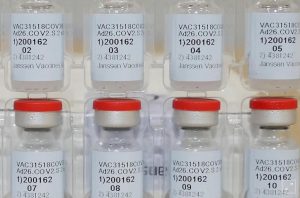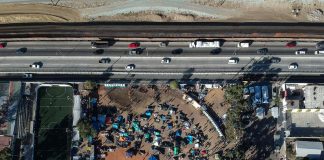FEBRUARY 26, 2021

This Dec. 2, 2020, photo provided by Johnson & Johnson shows vials of the Janssen COVID-19 vaccine in the United States.
A US government advisory committee voted unanimously Friday to recommend authorizing a COVID-19 vaccine from Johnson & Johnson for use in adults.
“I think authorization of this vaccine will help meet the needs at the moment,” committee member Dr. Archana Chatterjee, dean of the Chicago Medical School, said after casting her vote.
If the acting commissioner of the Food and Drug Administration agrees, as expected as soon as tomorrow, the vaccine could begin rolling out in the U.S. next week.
The J&J vaccine would be the third vaccine to reach Americans, joining ones from Moderna and Pfizer-BioNTech, which have been provided to 46 million people since December.
The approval of the FDA advisory group, known as the Vaccines and Related Biological Products Advisory Committee, was expected, because the company has met all the criteria the FDA established last year for a vaccine to be authorized: a large-scale trial proving safety and effectiveness and proof that the company can manufacture the vaccine consistently and safely.
All three vaccines are safe and effective, several committee members said after the vote.
“It’s important that people do not think that one vaccine is better than another,” said Dr. Cody Meissner, chief of the division of pediatric infectious disease at Tufts University School of Medicine in Boston.
“In this environment, whatever you can get, get,” added Dr. Arnold Monto, the committee’s acting chair and an epidemiologist at the University of Michigan School of Public Health.
Dr. Eric Rubin an infectious disease expert at the Harvard T.H. Chan School of Public Health, said voting to support the vaccine was a “relatively easy call.”
“It clearly gets way, way over the bar,” said Rubin, also editor-in-chief of the New England Journal of Medicine.
The J&J vaccine has several advantages over the other vaccines and one disadvantage: lower effectiveness.
In a large trial several months after the first two, the J&J vaccine was shown to be 72% effective in the United States and substantially less effective in South Africa and Latin America where two variants – which have now arrived in the United States – were spreading.
In the U.S., the vaccine appeared to be equally effective among all demographic groups, except among people over 60 with multiple medical problems in whom the effectiveness was lower.
Both Pfizer-BioNTech and Moderna’s vaccines were shown to be more than 94% effective last year when they were tested, though the arrival of the variants is also expected to reduce their effectiveness somewhat.
The presence of the variants increases the urgency of getting safe, effective vaccines out to the public, said committee member Dr. Jay Portnoy, a pediatric immunologist at the University of Missouri-Kansas City School of Medicine.
“We’re in a race between the virus mutating, new variants coming out that can cause further disease,” he said. “The fewer people who are infected with the virus, the less opportunity it has to emerge as a more virulent strain.”
“It’s great that we’re able to have this vaccine,” he added.
In terms of advantages, the J&J vaccine requires one shot, instead of two, which will provide protection faster. The company also is studying a two-dose regimen to see if that will prove substantially more effective.
The J&J vaccine is based on a more established technology than the other two. It uses a harmless virus to deliver a protein that trains the immune system to attack if it sees the virus that causes COVID-19.
It can also be stored longer in a refrigerator, making it easier to deliver to places that lack pharmaceutical-grade freezers. And it may have fewer side effects.
Members of the public are not expected to get a choice of which vaccine they want to take, and it’s not yet clear whether the J&J vaccine will be added to the broader pool or whether federal or state governments will decide to use it in a different way because of its distinct characteristics.
Rubin said it is a bit challenging to know how best to use this new vaccine, because there are still open questions about it, including whether it is effective enough in people over 60 who have several medical conditions.
“Having new information coming out constantly will really help us understand how best to apply this,” he said.
An advisory committee to the Centers for Disease Control and Prevention is meeting Sunday and Monday to discuss the vaccine and recommend how it should be used.
J&J has said that it will have 4 million doses of the vaccine to distribute immediately, 20 million total by the end of March and another 80 million by the end of June.
By mid-summer, the U.S. also expects to receive 300 million doses each of the Pfizer-BioNTech and Moderna vaccines, enough to vaccinate the vast majority of Americans.
Two more candidate vaccines, one from AstraZeneca and Oxford University and another from biotech Novavax, are working their way through the clinical trial process and are expected to request FDA authorization in the next few months.
The government pre-paid for all these vaccines, most for about $10 per dose, so they will be provided for no extra fee to the public. Insurance companies or government programs are expected to pick up the additional cost of actually delivering the shots.
The vaccines have not yet been authorized for use in children, though the Pfizer-BioNTech vaccine can be given to 16- and 17-year-olds, and the company expects to complete a study in younger adolescents this spring. J&J said Friday that it plans to begin a study in adolescents next week and younger children in the coming months.
Dr. Ofer Levy, a committee member and director of the Precision Vaccines Program at Boston Children’s Hospital, said he expects the J&J technology will work well in children. It has been used in other vaccines in children as young as four months, according to the company.
The vaccines are believed to be safe in pregnant women, though the trials did not include them. A small number of women in each of the trials became pregnant without any obvious problems associated with the vaccine.
Pfizer-BioNTech launched a trial last week to begin testing the vaccine in pregnant women. J&J also plans to begin a study in pregnant women in late March or early April, and a trial in immunocompromised people later this year.
To make shots available faster during the pandemic, the FDA is issuing so-called emergency use authorizations for the vaccines, rather than full approvals. The companies have followed the same process as would be required for full approval, but did not have to wait to look for longer-term effects.
The companies were required to follow at least half the trial participants for eight weeks after the shots to ensure safety before applying for emergency use authorization. Most health effects from vaccines occur in the first six weeks.
The companies will follow trial participants for two years. The government also has several methods for tracking safety of the vaccines as they are rolled out.
So far, those tracking systems have shown that both the Pfizer-BioNTech and Moderna vaccines have strong safety records. Roughly 2 to 5 out of every million people vaccinated has had a severe allergic reaction to the vaccines, but so far they have all recovered.
No one in the J&J trial reported an allergic reaction requiring epinephrine, but one person in a trial extension has reported such a response.
Dr. Tom Shimabukuro, a member of the CDC’s COVID-19 Vaccine Task Force, provided the committee Friday with an updated snapshot of the Pfizer-BioNTech and Moderna vaccines, concluding that no new safety concerns have arisen since the vaccines were rolled out to the public.
He provided some detailed information about side effects from the two vaccines, showing that both triggered more after the second dose.
Looking at several dozen conditions of particular concern, there were “no statistically significant increased risks detected,” Shimabukuro said.
Although a number of people have had serious health problems and even died within a few days of receiving a COVID-19 vaccine, there is no clear evidence that those problems were related to the vaccine and may have happened by chance.
Several committee members said the safety data on those vaccines gave them added comfort with the process they have used to review and authorize COVID-19 vaccines during a global emergency.
“This EUA process does seem to have worked, despite my own personal concerns about it six months ago,” said Patrick S. Moore, a professor at the University of Pittsburgh who studies cancer viruses.
“There is nothing surprising in terms of the safety, efficacy of the previously approved vaccines that occurred, and they’re being monitored,” Moore continued. “So in terms of vaccine hesitancy, one should be at least aware that experts are trying to take a look at this and trying to give the best possible answers in this emergency.”
Courtesy/Source: This article originally appeared on USA TODAY

































































































